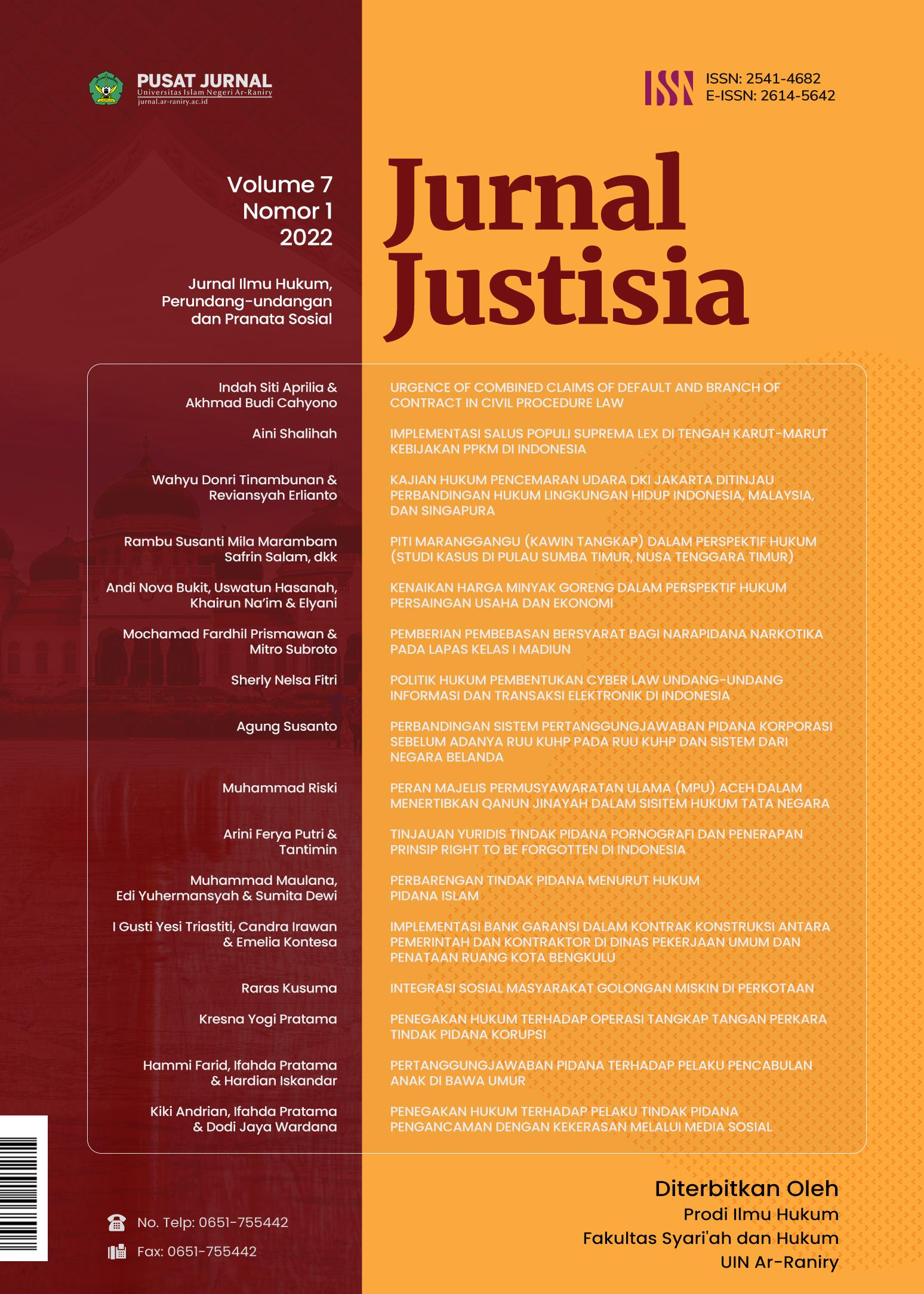Tinjauan Yuridis Tindak Pidana Pornografi dan Penerapan Prinsip Right to be Forgotten di Indonesia
DOI:
https://doi.org/10.22373/justisia.v7i1.12772Abstract
This study analyzes the crime of cyber pornography in the Indonesian legal system and the position of the rights of victims of cyber pornography in terms of the principle of rights to be forgotten. The method used is normative legal research that is prescriptive and applied, analyzing secondary data in the form of primary legal materials and secondary legal materials. Obtaining data using library research techniques and analyzed using the syllogism method with a deductive pattern. This study shows that pornography has complex legal arrangements in Indonesia, but cyber pornography does not yet have comprehensive regulations. An understanding of the position of the victim of the right to be forgotten in the case of cyber pornography can be based on the provisions of Article 26 of the ITE Law.References
Buku:
Arief, Barda Nawawi. 2006. Tindak Pidana Mayantara, Perkembangan Kajian Cyber Crime Di Indonesia. Jakarta: Raja Grafindo Persada.
Latif, Yudi. 2011. Negara ParipurnaHistoritas, Rasionalitas, Dan Aktualitas Pancasila. Jakarta: Kompas Media.
Marzuki, Peter Mahmud. 2008. Pengantar Ilmu Hukum. Jakarta: Kencana Prenada Media Group.
Marzuki, Peter Mahmud. 2014. Penelitian Hukum (Edisi Revisi). Jakarta: Kencana.
McLeod, Ian. 1996. Legal Method, Palgrave Macmillan, Hampshire.
Ramli, A. (2004) Cyber Law dan HAKI Dalam System Hukum Indonesia. Bandung: Refika Anditama.
Suliant, Feri. 2010. CyberPorn-Bisnis Atau Kriminal. Jakarta: Elek Media Komputindo.
Syahdeini, Sutan Remy. 2009. Kejahatan Dan Tindak Pidana Komputer. Jakarta: Pustaka Utama Grafiti.
Wacks, Raymond. 2012. Privacy and Media Freedom. Croydon: Oxford University Press.
Jurnal:
Adebayo, Haleemah Bukoola. 2018. “Trajectories of University of Ibadan Udergraduates ‘Exposure to Cyber Pornography.’” Journal of Social, Behavior, and Health Science 12(1).
Apriadi, Indra. 2010. “Laporan Akhir Penulisan Karya Ilmiah Tentang Implementasi Regulasi Pornografi Di Indonesia.” Kementerian Hukum Dan Hak Asasi Manusia. Badan Pembinaan Hukum Nasional.
Christianto, Hwian. 2020. “Konsep Hak Untuk Dilupakan Sebagai Pemenuhan Hak Korban Revenge Porn Berdasarkan Pasal 26 Undang-Undang Informasi Dan Transaksi Elektronik.” Mimbar Hukum - Fakultas Hukum Universitas Gadjah Mada 32(2). doi: 10.22146/jmh.51110.
DeKesredy, Walter. 2015. “Critical Criminological Understandings of Adult Pornography and Woman Abuse: New Progressive Directions in Research and Theory.” International Journal for Crime, Justice and Social Democracy 4(4).
Ismail, Mahsun. 2019. “Kebijakan Hukum Pidana Cyberpornography Terhadap Perlindungan Korban.” Jurnal Hukum Ekonomi Syariah 1(2). doi: 10.30595/jhes.v1i2.3734.
Karo., Rizky P. P. Karo. 2019. “Perlindungan Hukum Atas Privasi Dan Data Pribadi Masyarakat.” Hukumonline.Com. Retrieved (https://www.hukumonline.com/klinik/a/perlindungan-hukum-atas-privasi-dan-data-pribadi-masyarakat-lt5d588c1cc649e).
Krismiyarsi. 2015. “Criminal Law Enforcement of Cyberporn/Cybersex in Order to Fighting Crime in Indonesia.” International Journal Bussiness, Economi, an Law 8(4).
Kumar, Alok Prasanna. 2017. “Right to Be Forgotten’ in Indian Law.” Economic and Political Review 52(11).
Nugraha, Ridha Aditya. 2020. “Perlindungan Data Pribadi Dan Privasi Penumpang Maskapai Penerbangan Pada Era Big Data.” Jurnal Mimbar Hukum 30(2).
Rene, Yulia. 2012. “Restorative Justice Sebagai Alternatif Perlindungan Hukum Terhadap Korban Kekerasan Dalam Rumah Tangga.” Jurnal Hukum Dan Pembangunan 2(1).
Saulawa, MA. 2015. “Cyber Pornography: Analysis Of the Legal Framework.” Global Journal of Politics and Law Research Faculty of Law 3.
Surbakti, Natangsa. 2011. “Mediasi Penal Sebagai Terobosan Alternatif Perlindungan Hak Korban Tindak Pidana.” Jurnal Ilmu Hukum 14(1).
Susilo, Ignatius Bagus. 2003. Kompilasi Instrumen Internasional Hak Asasi Manusia Berikut Ratifikasinya Dalam Peraturan Perundangundangan Di Indonesia. Surabaya: Pusat Studi Hak Asasi Manusia Universitas Surabaya.
Peraturan Perundang-Undangan:
Undang-Undang Dasar Negara Republik Indonesia 1945
Kitab Undang-Undang Hukum Pidana
Undang – Undang Nomor Nomor 43 Tahun 1999 tentang Pers
Undang – Undang 32 Tahun 2002 tentang Penyiaran
Undang – Undang 3 Tahun 2002 tentang Perlindungan Anak
Undang – Undang Nomor 44 tahun 2008 tentang Pornografi
Undang – Undang Nomor 11 Tahun 2008 tentang Informasi dan Transaksi Elektronik
Undang – Undang Nomor 33 Tahun 2009 tentang Perfilman
Peraturan Pemerintah Nomor 18 Tahun 2014 tentang Lembaga Sensor Film
Downloads
Published
Issue
Section
License
The Authors submitting a manuscript do so on the understanding that if accepted for publication, copyright of the article shall be assigned to Jurnal Justisia : Jurnal Ilmu Hukum, Perundang-undangan dan Pranata Sosial, Ar-Raniry State Islamic University, Indonesia as the publisher of the journal.
Jurnal Justisia : Jurnal Ilmu Hukum, Perundang-undangan dan Pranata Sosial right of first publication with the work simultaneously licensed under Creative Commons Attribution-ShareAlike 4.0 International License (CC BY-SA 4.0) that allows others to share (copy and redistribute the material in any medium or format) and adapt (remix, transform, and build upon the material) the work for any purpose, even commercially with an acknowledgment of the work's authorship and initial publication in Jurnal Justisia : Jurnal Ilmu Hukum, Perundang-undangan dan Pranata Sosial. Authors are able to enter into separate, additional contractual arrangements for the non-exclusive distribution of the journal's published version of the work (e.g., post it to an institutional repository or publish it in a book), with an acknowledgment of its initial publication in Jurnal Justisia : Jurnal Ilmu Hukum, Perundang-undangan dan Pranata Sosial. Authors are permitted and encouraged to post their work online (e.g., in institutional repositories or on their website) prior to and during the submission process, as it can lead to productive exchanges, as well as earlier and greater citation of published work (See The Effect of Open Access).

